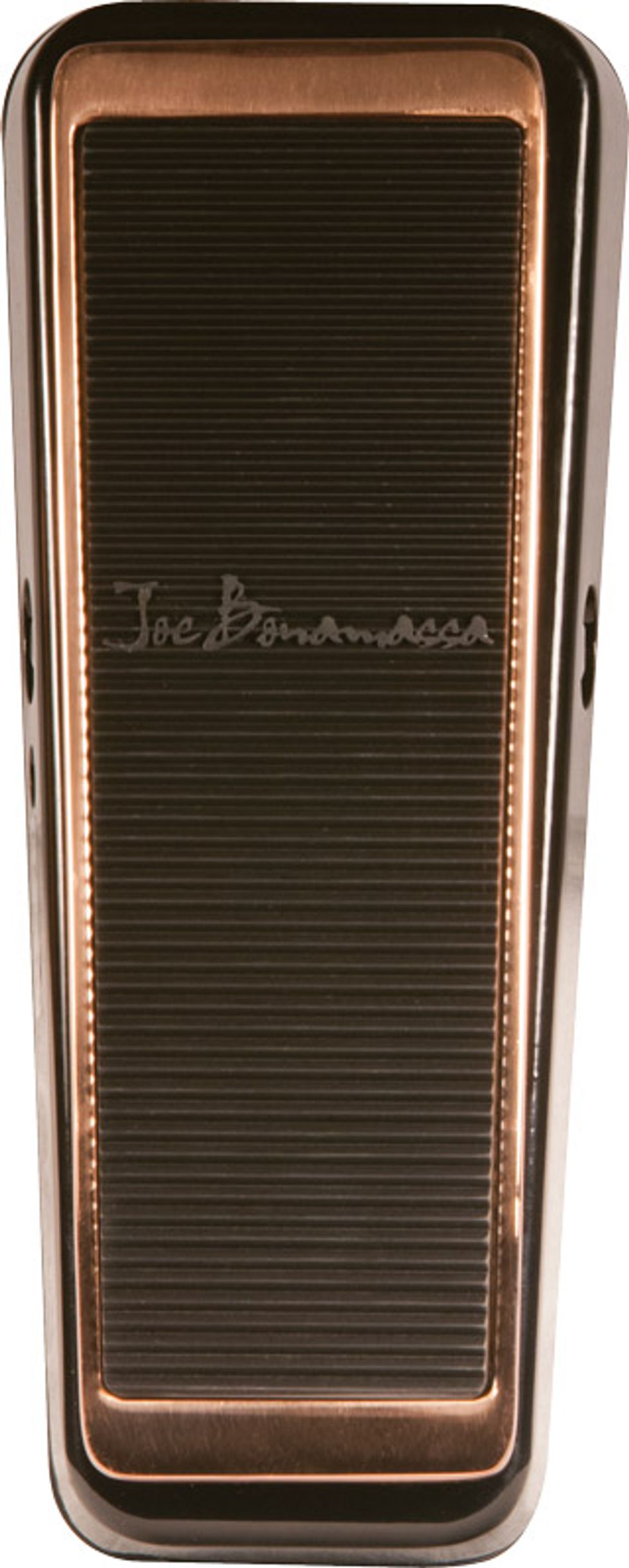
Few guitar effects—or musical instruments, for that matter— made as much impact on arrival as the wah pedal. And at the feet of Hendrix, Clapton, Mayfield, and Wah Wah Watson, it helped define the sound of ’60s guitar and ’70s funk. Brad Plunkett created the original circuit in the late ’60s as a replacement for the MRB (mid range boost) switches on a Vox amplifier. But when the switch was replaced by a potentiometer and the circuit placed in an organ’s volume pedal, Plunkett’s creation became a history- making, tone-altering monster.
It didn’t take long for wah to mutate into an effect of a thousand flavors. And perhaps nowhere does the rainbow of wah sounds exist in more numerous colors than in the Jim Dunlop line. Dunlop has developed signature pedals to suit Kirk Hammett, Jerry Cantrell, Slash, Zakk Wylde, and Eddie Van Halen, as well as Jimi Hendrix signature wahs built to the spec of his original Thomas Organ-designed unit. Now, Dunlop has honored bluesrock legend Joe Bonamassa with his own signature wah, the JB95, which is modeled on his custom wah and packed with special modifications to capture his distinctly vintage tone.
Canary in a Copper Mine
Like his signature Fuzz Face,
Bonamassa’s JB95 Cry Baby sports
a shiny copper rocker—a very eyecatching
and luxurious touch. The
top surface is a textured rubber
pad. The lower half of the JB95 is
done up in a sleek, gloss-black finish.
It’s a hefty unit on the whole,
and if you’ve ever had a regular
Cry Baby that seemed to last
through droughts, hurricanes, and
a million beer-soaked bar gigs in
its lifetime, this one feels built to
last twice as long.
Inside the JB95, things look every bit as sturdy and precise. The 9V battery compartment is secured to the bottom plate and can be accessed without removing all four screws, though a standard barrel adaptor may also be used for power. One of the most critical components in Bonamassa’s signature wah is the halo inductor. Halos appeared in the early Vox wahs and are considered one of the keys to their rich, vocal capability. And while debate rages among wah heads about the true significance of inductors in the overall tone of a wah, many regard the halo as an indispensable part of the best vintage-wah sounds.
You’ll also find a unique truebypass toggle inside that allows you to switch the operation on and off. Apparently, Mr. Bonamassa prefers the coloration achieved without true bypass. Thankfully for true-bypass adherents, this pedal gives you an option.
Sweep for Days
With a mini humbuckerequipped
Epiphone Firebird, a
Stratocaster, and a range of amps
from a 13-watt Fender Excelsior
to a Twin Reverb, the Bonamassa
seemed at home and capable
regardless of the amp/guitar combination.
Leaving the wah in nontrue-
bypass mode means you can
engage the on/off switch almost
noiselessly. Once the JB95 is on,
it’s hard not to be drawn right
into the sweet, high-end range of
the pedal’s sweep, which has the
pleasing whine and longing tones
of a permed and SG-wielding
Clapton. Rocking back to the heel
position plummets you deep into
a cavernous low end that turns in
a throaty bellow when coupled
with an overdrive or a saturated
tube amp. The bassiest tones
aren’t quite as low as say, a vintage
Macari, but the range of frequency
modulation is astounding, and
it may take you some time and
a delicate touch to get used to
micromanaging the rocker if
you’re accustomed to a ham-fisted
potentiometer of a cheaper wah.
Ratings
Pros:
Wide, expressive sweep. Sweet, low and high end.
Cons:
No additional tone-tweaking controls beyond
standard wah treadle.
Tones:
Ease of Use:
Build:
Value:
Street:
$169
Dunlop
jimdunlop.com
The Bonamassa wah was designed with an output buffer so it would work better with fuzzes (and Fuzz Faces in particular). All too often you dial in a fuzz tone that’s perfect, only to have your wah suck the character entirely. But both a NYC Big Muff and Fuzzrite clone retained their respective voices and the JB95’s sweep-accentuating frequencies in a manner that seemed to work hand in hand with the fuzz. Switching the toggle into true bypass gives the tone a touch more high end which worked fine with the Muff, but was a bit brittle for the already trebly Fuzzrite.
The Verdict
Dunlop might not be able to
talk a vintage-wah fiend out of
shelling out hundreds of dollars
on eBay for a vintage Vox or Cry
Baby. Any player that’s less obsessive
about such matters (or nonflush
with cash), however, should
give the Bonamassa JB95 a spin.
It’s suitable for just about any
amp, pickup, and pedal combination,
provided you set up your
chain right. And details like the
halo inductor help get you very
close to the specs of a vintage
unit. But more importantly, the
Bonamassa performs in so many
of the ways that make purists
long for a vintage wah—long
and expressive sweeps, deep lows,
and rich, high end. The $169
street price isn’t pocket change,
but given the quality,
the brilliant
tones, and what
you could pay
for a vintage
unit or highend
clone, the
Bonamassa
Cry Baby is a
bargain.










![Rig Rundown: Russian Circles’ Mike Sullivan [2025]](https://www.premierguitar.com/media-library/youtube.jpg?id=62303631&width=1245&height=700&quality=70&coordinates=0%2C0%2C0%2C0)








